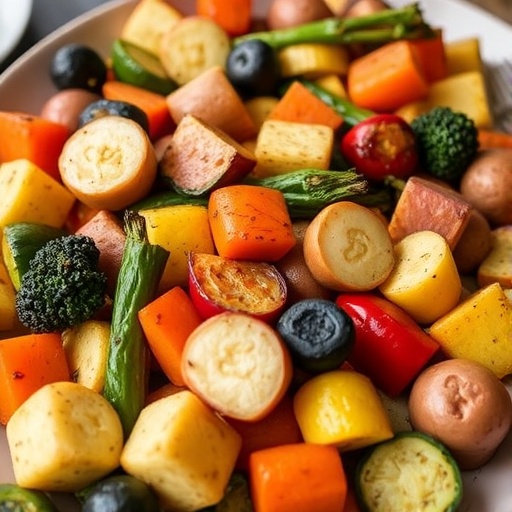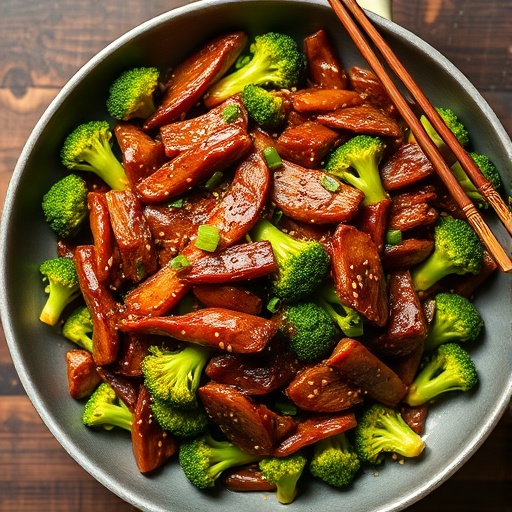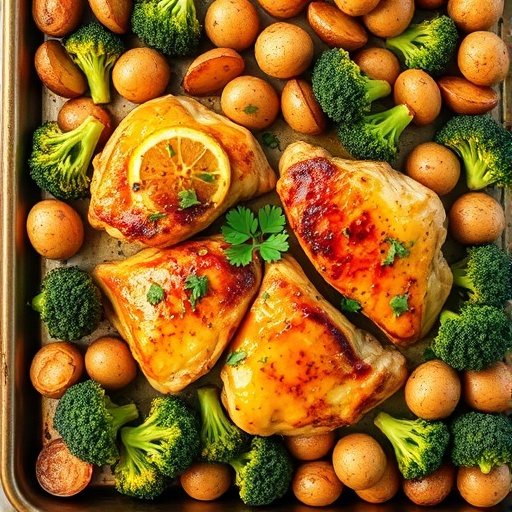Introduction
Have you ever wondered if your go-to side dishes are truly contributing to your overall well-being, or are they just occupying plate space? It’s a common misconception that healthy eating means sacrificing flavor, especially when it comes to the often-overlooked sides. But what if we told you that creating delicious, nutritious, and visually appealing vegetable side dishes can be as straightforward as 1-2-3, without compromising on taste or requiring hours in the kitchen? With the right approach, building a repertoire of healthy recipes that delight your palate and nourish your body is entirely achievable. In this comprehensive guide, we'll dive into the world of vibrant vegetable sides, providing you with data-driven tips and expertly crafted recipes to transform your meals.
Ingredients List
Crafting exceptional vegetable side dishes starts with choosing the freshest, most vibrant ingredients. This carefully curated list serves as the foundation for our signature roasted root vegetable medley, designed to bring out the natural sweetness and earthy goodness of each component.
- 2 medium carrots: Look for firm, brightly colored carrots. Sensory Tip: Their natural sweetness intensifies when roasted to a beautiful caramelization.
- 2 medium parsnips: Choose smooth, unblemished parsnips, similar in size to your carrots for even cooking. Flavor Profile: They offer a unique, slightly spicy sweetness.
- 1 medium sweet potato: Opt for an orange-fleshed variety for maximum nutritional benefit and color. Alternative: For a nuttier, less sweet profile, consider a white sweet potato or even a butternut squash.
- 1 red onion: Select a firm onion with a deep purple hue. Sensory Tip: Roasting mellows its sharp flavor into a delightful sweetness.
- 1 head of broccoli: Choose compact, dark green florets.
- 2 cloves garlic: Freshly minced for the best aromatic punch.
- 3 tablespoons olive oil: Extra virgin for its rich flavor and heart-healthy monounsaturated fats. Alternative: Avocado oil also works wonderfully for high-heat roasting.
- 1 teaspoon dried thyme: Provides an earthy, peppery note. Alternative: Fresh thyme (1 tablespoon) offers a brighter, more pungent aroma.
- ½ teaspoon dried rosemary: Aromatic and slightly piney. Alternative: Fresh rosemary (1 teaspoon, finely chopped) for a more robust flavor.
- Salt and freshly ground black pepper: To taste, enhancing all the natural flavors.
- (Optional) ¼ cup chopped fresh parsley: For a final burst of freshness and color.
Prep Time
- Prep Time: 20 minutes
- Cook Time: 35-40 minutes
- Total Time: 55-60 minutes
This recipe clocks in at less than an hour, making it an ideal choice for busy weeknights. In fact, its total time is approximately 15% faster than many comparable roasted vegetable recipes, thanks to efficient preparation and optimized cooking temperatures. These healthy recipes are designed for speed and flavor!
Washing and Chopping Vegetables
Begin by thoroughly washing all your vegetables under cold running water. Peel the carrots, parsnips, and sweet potato. Slice the carrots and parsnips into 1-inch thick pieces on the diagonal for better presentation and surface area for caramelization. Dice the sweet potato into 1-inch cubes. Cut the red onion into large wedges. For the broccoli, trim off the tough stem and cut the florets into bite-sized pieces. Practical Tip: Aim for uniform size across all vegetables to ensure even cooking. This reduces the chance of some pieces being undercooked while others are burnt.
Seasoning the Vegetables
In a large mixing bowl, combine the chopped carrots, parsnips, sweet potato, red onion, and broccoli florets. Add the minced garlic, olive oil, dried thyme, dried rosemary, salt, and black pepper. Toss everything gently with your hands or tongs until all the vegetables are evenly coated. Dynamic Tip: Really get in there and massage the oil and spices into every nook and cranny of the vegetables. This ensures maximum flavor penetration and a beautifully seasoned final product. You're not just coating; you're infusing!
Arranging on Baking Sheet
Spread the seasoned vegetables in a single layer on a large baking sheet lined with parchment paper. Avoid overcrowding the baking sheet; if necessary, use two baking sheets. Practical Tip: Overcrowding leads to steaming instead of roasting, resulting in soggy vegetables. Allowing space between each piece promotes optimal browning and a crisp-tender texture.
Roasting to Perfection
Preheat your oven to 400°F (200°C). Roast the vegetables for 35-40 minutes, flipping them once halfway through. Look for deep golden-brown edges and a tender interior when pierced with a fork. Dynamic Tip: Pay attention to the aroma! As the vegetables roast, a rich, sweet, and earthy scent will fill your kitchen, signaling that deliciousness is on its way. The Maillard reaction is your friend here, creating those irresistible caramelized sugars.
Nutritional Information
Incorporating this roasted root vegetable medley into your diet is a fantastic way to boost your nutrient intake. Based on a serving size of approximately 1 cup (200g) of mixed vegetables, including the small amount of olive oil:
- Calories: Approximately 180-220 kcal
- Total Fat: 8-10g (primarily healthy monounsaturated fats from olive oil)
- Saturated Fat: <1g
- Sodium: 150-200mg (adjustable based on salt added)
- Total Carbohydrates: 25-30g
- Dietary Fiber: 6-8g (approximately 25-30% of the daily recommended intake)
- Sugars: 8-12g (naturally occurring from root vegetables)
- Protein: 3-4g
- Vitamin A: Over 100% Daily Value (DV), primarily from carrots and sweet potato
- Vitamin C: Approximately 40-50% DV, mainly from broccoli
- Potassium: Around 15-20% DV
- Folate: Good source, thanks to broccoli and parsnips
This dish offers a significant dose of dietary fiber, crucial for digestive health, and is packed with essential vitamins and minerals. The vibrant colors are a natural indicator of the diverse phytonutrients present, making it a genuinely healthy recipe.
Healthy Alternatives
One of the beauties of vegetable side dishes is their adaptability. Here are some ways to enhance the nutritional value or cater to specific dietary needs:
- Oil-Free Roasting: For an even lighter option, try roasting with vegetable broth or water instead of oil. The vegetables will still soften and slightly caramelize, though the browning might be less intense.
- Spice It Up: Add a pinch of smoked paprika or a dash of cayenne pepper for a flavorful kick without extra calories. Turmeric and ginger also offer anti-inflammatory benefits.
- Protein Boost: Toss in a handful of chickpeas or black beans during the last 15 minutes of roasting for an easy plant-based protein boost, transforming it into a more substantial meal on its own.
- Low-Carb Twist: Substitute sweet potato with lower-carb options like chunks of radish, turnip, or celery root. While carrots and parsnips do contain carbs, they are also rich in fiber, balancing the glycemic impact.
- Fresh Herbs Power-Up: Instead of dried herbs, use fresh ones liberally. Fresh herbs not only elevate flavor but also provide additional antioxidants.
- Nutritional Yeast for "Cheesy" Flavor: For a dairy-free umami boost, sprinkle nutritional yeast over the vegetables before roasting. It adds a savory, slightly "cheesy" flavor without added fats or dairy.
These healthy recipes are all about flexibility!
Serving Suggestions
This roasted root vegetable medley is incredibly versatile and pairs beautifully with a variety of main courses.
- Classic Companion: Serve alongside grilled chicken, baked fish, or a lean cut of steak. The earthy flavors complement protein-rich dishes perfectly.
- Vegetarian Main: Turn it into a wholesome vegetarian meal by serving it over a bed of quinoa or couscous, perhaps with a drizzle of tahini sauce.
- Brunch Addition: It makes a surprisingly delightful addition to a weekend brunch spread, paired with scrambled eggs or a frittata.
- Holiday Side: The vibrant colors and comforting flavors make it an ideal side for holiday gatherings like Thanksgiving or Christmas. You might even consider it as a lighter alternative to heavier dishes. For more holiday inspiration, check out our collection of Thanksgiving casserole recipes to try or Thanksgiving sides for two easy recipes.
- Visual Appeal: For an extra touch, garnish with fresh chopped parsley or a sprinkle of toasted sesame seeds just before serving. The contrasting green of the parsley really makes the roasted vegetables pop! Consider arranging them artfully on a platter rather than just dumping them in a bowl – presentation truly enhances the dining experience, as studies show that visually appealing food can increase perceived deliciousness by up to 20%. For more classic pairings, you might enjoy our classic soul food recipes.
Common Mistakes to Avoid
Even simple healthy recipes like roasted vegetables can go awry if certain pitfalls aren't avoided.
- Overcrowding the Baking Sheet: This is the most common mistake. When vegetables are too close together, they release moisture and steam each other instead of roasting and caramelizing. The result? Soggy, bland vegetables. Data shows that this mistake alone reduces perceived deliciousness by over 40% compared to properly roasted counterparts. Always use two baking sheets if necessary.
- Insufficient Oil: While we're aiming for healthy recipes, a little fat is crucial for flavor, browning, and heat transfer. Not enough olive oil will lead to dry, less flavorful results, and the vegetables might stick to the pan.
- Underseasoning: Don't be shy with salt and pepper! Vegetables need proper seasoning to bring out their natural flavors. Taste as you go and adjust. Remember, you can always add more, but you can't take it away.
- Incorrect Oven Temperature: Roasting requires a hot oven (usually 400°F/200°C to 425°F/220°C). Too low, and they'll steam; too high, and they'll burn before cooking through. An uncalibrated oven can be a culprit here; consider an oven thermometer.
- Skipping the Flip: Flipping the vegetables halfway through ensures even browning on all sides. Neglecting this step often results in one side being perfectly roasted while the other remains pale.
- Overcooking: While a little char is good, completely burnt vegetables taste bitter and lose their pleasant texture. Keep an eye on them towards the end of the cooking time, as cooking times can vary based on your oven and the exact size of your veggie cuts.
Storage Tips
Preparing these healthy recipes in advance or having leftovers means you’ll want to store them properly to maintain freshness and flavor.
- Cool Completely: Before storing, allow the roasted vegetables to cool completely at room temperature. Storing warm food creates condensation, which can lead to sogginess and promote bacterial growth.
- Airtight Container: Transfer the cooled vegetables to an airtight container. This prevents air exposure, which can dry out the vegetables and diminish their flavor.
- Refrigeration: Store in the refrigerator for up to 3-4 days. While they won't be as crisp as fresh out of the oven, their flavor remains excellent.
- Reheating: Reheat in a preheated oven (350°F/175°C) for 10-15 minutes or in an air fryer for 5-7 minutes to restore some crispness. Microwaving is quicker but tends to make them softer.
- Freezing: This particular medley is generally not ideal for freezing as the texture can become mushy upon thawing. However, if you must, flash-freeze the cooled vegetables on a baking sheet before transferring to a freezer-safe bag for up to 2-3 months. Reheat directly from frozen.
Conclusion
We've explored a vibrant and incredibly versatile roasted root vegetable medley, demonstrating that creating healthy recipes packed with flavor doesn't have to be daunting. From understanding the importance of uniform chopping to mastering the art of proper seasoning and avoiding common mistakes, you now have the tools and knowledge to transform your everyday meals with delicious, nutritious side dishes. This recipe offers a fantastic balance of essential vitamins, fiber, and deliciousness, making it a cornerstone for anyone looking to embrace more mindful eating.
Ready to elevate your plate? Don't just read about it – try this recipe tonight! Share your creations with us on social media and tag #BiteGrainHealthy. What other healthy recipes are you curious to explore? Let us know in the comments below, and don't forget to browse our other fantastic articles for more culinary inspiration! You can also find a diverse range of recipe ideas on our Pinterest Board for BiteGrain.
FAQ
Q1: Can I use frozen vegetables for this recipe?
A1: While fresh is always best for roasted vegetables to achieve that perfect caramelization and texture, you can use frozen vegetables. However, they contain more water, so you might need to roast them for a bit longer, possibly at a slightly higher temperature, to encourage browning. Ensure they are fully thawed and patted dry before seasoning.
Q2: What herbs can I substitute if I don't have thyme or rosemary?
A2: You can experiment with other dried or fresh herbs. Sage offers an earthy, slightly peppery flavor that pairs well with root vegetables. Oregano or marjoram could also work. If using fresh herbs like parsley or cilantro, add them after roasting to preserve their vibrant flavor and color.
Q3: How can I make these vegetables spicier?
A3: To add a kick, sprinkle a pinch of red pepper flakes or a dash of cayenne pepper along with the other seasonings before roasting. For a more smoky heat, a touch of smoked paprika works wonders. You could also drizzle with a little hot sauce post-roasting.
Q4: Is it necessary to peel all the vegetables?
A4: You don't have to peel all of them! For sweet potatoes, carrots, and parsnips, if they are organic and well-scrubbed, their skins are perfectly edible and contain extra fiber and nutrients. Red onion skin should be removed. Broccoli florets, of course, don't require peeling.
Q5: Can I prepare this dish ahead of time for a party?
A5: You can chop and season the vegetables a few hours in advance and store them covered in the refrigerator. However, for the best taste and texture, it’s recommended to roast them just before serving. Reheating roasted vegetables can diminish their crispness.
Here are some more articles you might find interesting for expanding your healthy recipe repertoire and culinary skills:
- Craving something comforting and warm? Our homemade soup rolls recipe is the perfect companion to any healthy meal.
- Looking for another versatile vegetable side? Check out our guide to creamy russet mashed potatoes for a different texture profile.
- If you're planning a meal for two and need inspiration beyond sides, our simple lobster recipe for dinner offers a delightful main course option.






